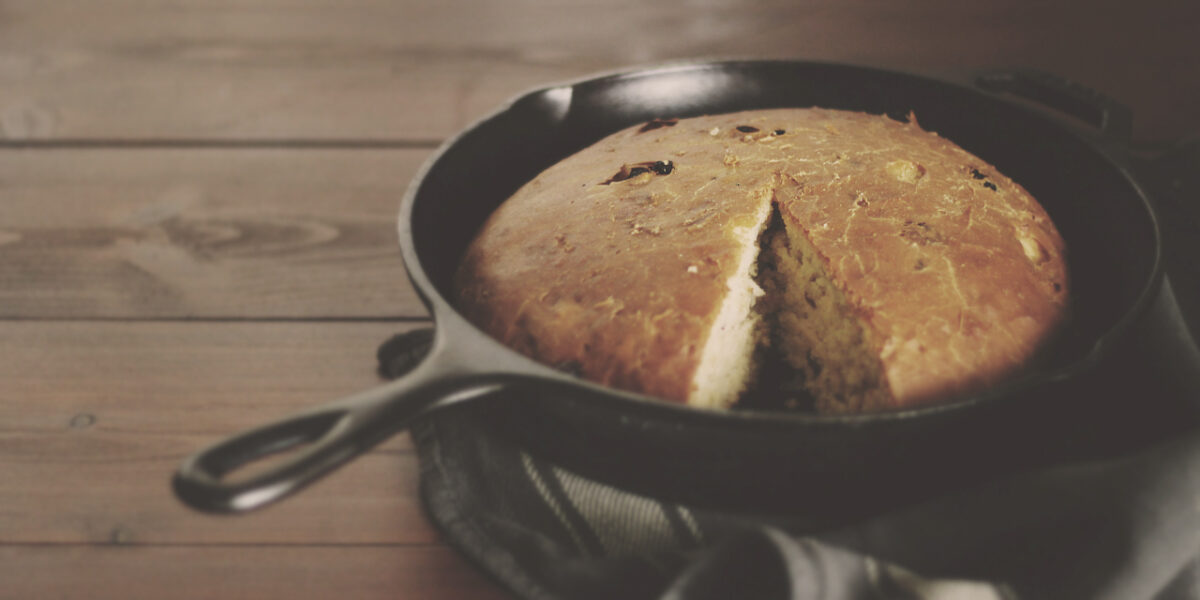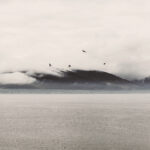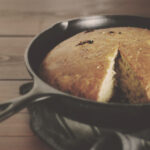If every Frenchwoman is born with a wooden spoon in her hand, every Scotswoman is born with a rolling pin under her arm, for it is certain that she has developed a remarkable technique in baking bannocks, scones and oatcakes.
F. Marian McNeill, The Scots Kitchen (1929)
Once a firm favourite of the Scottish fireside, the bannock is a ubiquitous feature of the Scottish folktale, often offered as sustenance to a hungry stranger, left outside a door as a gift for the fairies, or given in payment for a hard day’s work. This humble fare has sustained Scotland for centuries and is ingrained in the country’s folklore and traditions.
The word bannock itself comes from the Gaelic bannach or bonnach, meaning morsel, presumably relating to the fact that bannocks were often made with the leftover crumbs and dust from previous baking or milling grain – it was thought to be unlucky not to use every last scrap. If the remnants were swept back into the meal-chest, the Carlin would come to sit on the chest until she’d eaten up all the luck of the family, so any leftovers would be carefully gathered up, mixed with fat, and made into bannocks.
The bannock was cooked on the clach-bhannag, or bannock stone, a D-shaped piece of hewn sandstone heated directly on the fire. In more recent times, the bannock would be cooked on a girdle, a flat disc of wrought iron with a semicircular handle allowing it to be hung over the fire for cooking. Amongst the rural population especially, the girdle took the place of the oven and the bannock of the loaf.
There are countless varieties of bannock, and the distinction between bannocks, scones, and oatcakes is often a difficult one to make. Many sources use the three interchangeably. The oldest version is a simple unleavened flatbread, made with flour, meal, or oats, and whatever butter, dripping, or lard was available. A little water is added to make a soft, sticky dough, which is then divided into portions, rolled into balls, and pressed flat between the hands, or left whole and rolled out into one large, round cake. It was considered bad luck to count bannocks after they were made, and a bannock falling and breaking was a very bad omen indeed.
Small bannocks were formed with a hole in the middle as protection against witchcraft and the influence of the sith, reminiscent of talismans against the evil eye. These were given to children as a reward for carrying out chores or errands, but if the reason for gifting the bannock was explained to the recipient, the charm would be broken.
At Yule, the winter solstice, the Yule bannock was made between noon and six o’clock before being baked over the Cailleach Nollaig. Its edges were indented to depict the rays of the sun, and each person in the house was required to turn the bannock sunwise as it cooked to ensure that bad luck would not befall the family. It was customary to drop trinkets for divination into the batter, the forerunner to the tradition of charms in a clootie dumpling, or a silver sixpence in a Christmas pudding.
On the cross-quarter days, a large family bannock was baked along with a smaller bannock for each member of the family. The bannocks’ names corresponded with the festivals: the bonnach Brid, or bannock of Bride for Imbolc, the first day of spring; the bonnach Bealltain, or Beltane Bannock for the first day of summer; the bonnach Lùnastal, or Lughnasadh bannock, for the first day of autumn; and the bonnach Samhain, or Samhain bannock, for the first day of winter.
Once these quarter-cakes were baked, the family would make its way outside with their bannocks where they would break off small pieces and throw them over each shoulder as they ate, each piece an offering to placate a creature that endangered the families livestock, for example, “Here to you, wolf, spare my sheep; there to you, fox, spare my lambs; here to you, eagle, spare my goats; there to you, raven, spare my kids; here to you, marten, spare my fowls; there to you, harrier, spare my chickens.”
This folk magic, it was hoped, would ensure a few months of safe and successful farming.
At Imbolc, a coin or metal charm was dropped into the mix. Everyone in the house ate a piece of the bannock once it was cooked, and the person who found the coin or charm was predicted to marry within the year. Any unused meal was sprinkled over the sheep as a protective blessing.
At Beltane, in many places across Scotland, it was customary for the children of a community to mark the day by gathering on top of a hill and rolling bannocks down it. In The Popular Superstitions of the Highlands of Scotland, William Stewart recalls:
“The children are presented each with a bannock, with as much joy as an heir to an estate his title-deeds; and having their pockets well lined with cheese and eggs, to render the entertainment still more sumptuous, they hasten to the place of assignation, to meet the little band assembled on the brow of some sloping hill, to reel their bannocks, and learn their future fate.
With hearty greetings they meet, and with their knives make the signs of life and death on their bannocks. These signs are a cross, or the sign of life, on the one side; and a cypher, or the sign of death, on the other. This being done, the bannocks are all arranged in a line, and on their edges let down the hill. This process is repeated three times, and if the cross most frequently present itself, the owner will live to celebrate another Belton day; but if the cypher is oftenest uppermost, he is doomed to die of course.
This sure prophecy of short life, however, seldom spoils the appetites of the unfortunate short-livers, who will handle their knives with as little signs of death as their more fortunate companions. Assembling around a rousing fire of collected heath and brushwood, the ill-fated bannocks are soon demolished, amidst the cheering and jollity of the youthful association.”
Another Beltane tradition was that of the sooty bannock, in which a bannock was baked and broken into pieces and a single piece charred black in the fire. These pieces were then placed into a bonnet or bag and offered around, and whoever picked out the sooty bannock was declared the Beltane Carlin. In more recent times, the Carlin’s forfeit was to leap through the flames of the Beltane bonfire three times or to be pelted with eggshells, but thousands of years ago it’s quite likely that picking the blackened bannock would have been much more dangerous.
In 1984, in Lindow Moss near Cheshire, the body of a young man dating back to the Iron Age was found preserved in a peat bog. The body bore signs of having undergone a ritual murder known as the triple death: strangulation, wounding, and drowning, and it was also discovered that the stomach contained little more than a piece of charred bannock. The Celtic scholar and archaeologist, Anne Ross, believes that Lindow Man participated in a blackened bannock ceremony and as a result of picking out the scorched piece he was ceremonially killed, a sacrifice to the gods to ensure that the following summer’s crops would be successful.
On Lammas, a bannock was made from the grain milled from the first ears of corn picked that day, and toasted on a fire of rowan wood. Once baked, the head of the family would break the bannock up and give a piece to his wife, and a piece to each of his children, in age order, before they all walked sunwise around the fire. The embers of the fire are then placed in a pot and carried sunwise around the outside of the family home, and around any steadings and fields, where all the flocks would be gathered for this protective blessing.
Bannach bruader, or dreaming bannocks, were made at Samhain, the night when the veil between the worlds of the living and the dead is said to be at its thinnest, making it an auspicious time for divination and auguries. Salt and soot were added to the mixture before it was baked hard and broken into pieces. The baker must be completely silent during the process, or the charm won’t work. Those in the household who were not yet married were given a piece of the bannock to put under their pillow in the hope it would induce a dream of their future spouse.
Since the advent of the oven and with easier access to leavening agents, the bannock has evolved into a much lighter and more bread-like cake. The popular Selkirk Bannock, a modern yeasted variation packed with fruit, originated in the bakery of Robbie Douglas in the late 1800s. During a visit to Abbotsford, the residence of Sir Walter Scott, Queen Victoria is reputed to have taken her tea with a slice of the Selkirk bannock, and its popularity has flourished and endured ever since.
My favourite bannock is a far cry from unsweetened flatbreads of old. This one is enriched with butter and sugar, and is a real treat toasted and slathered with salted butter.
The Bannock
Ingredients
- 7 g easy bake or fast action yeast
- 1 tsp sugar
- 500 g plain or strong flour
- 125 g unsalted butter, melted
- 200 g sultanas
- 50 g light brown sugar
Instructions
- In a large bowl, mix together the yeast, sugar, and 250ml of lukewarm water. Leave to stand for ten minutes until frothy.
- Add the melted butter and the flour to the yeast mixture and stir until thoroughly combined. Tip on to a lightly floured surface and knead for about five minutes. The dough should be smooth and elastic.
- Place the dough into a clean bowl and cover with a damp tea towel. Leave to prove in a warm place for about an hour or until doubled in size.
- Once the dough has risen, remove the tea towel and punch the dough down. Tip onto a lightly floured surface and add the brown sugar and sultanas. Fold the dough over the sugar and sultanas and knead until well combined.
- Shape the dough into a round and place in the centre of a lightly greased cast iron pan, or on to a baking sheet. Leave to rise in a warm place again for half an hour or until it's double in size.
- Preheat the oven to 180°C/350°F/GM 4.
- Bake the bannock for 45-50 minutes until risen and golden brown. If the bread is getting too dark, cover lightly with foil. When the bread is ready it should sound hollow when you tap the bottom of it.






Paddy says:
A couple of Scottish folk tales I have read recently mention the Bannock and it’s good to be able to understand more how connected they were to everyday life.
June 9, 2023 — 10:19 am